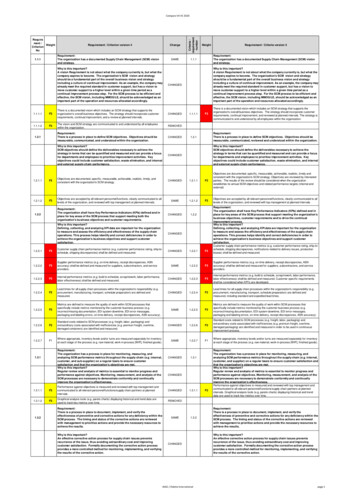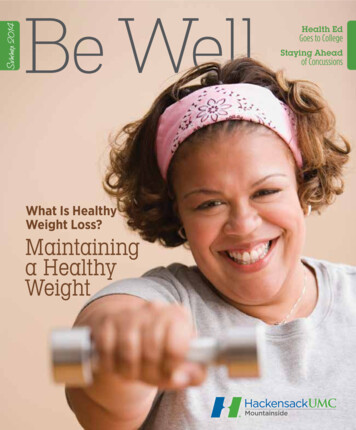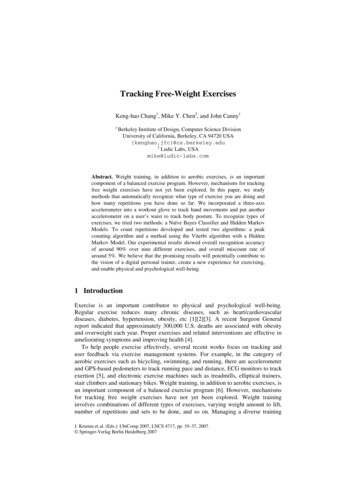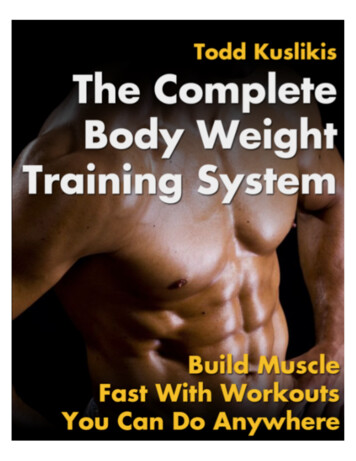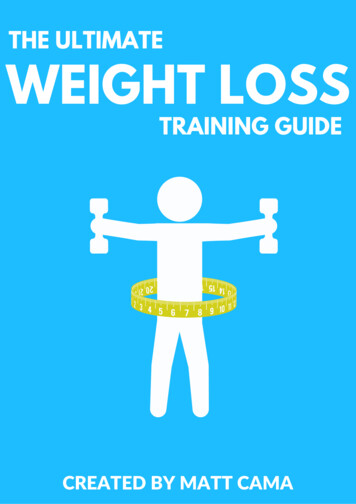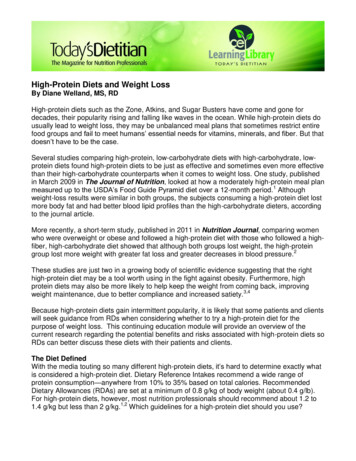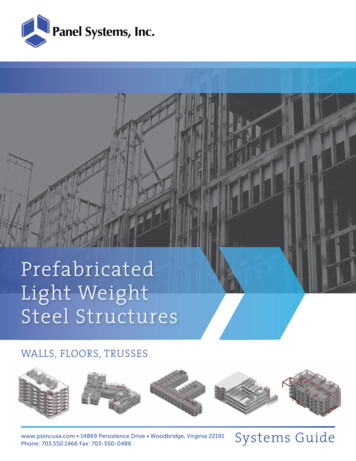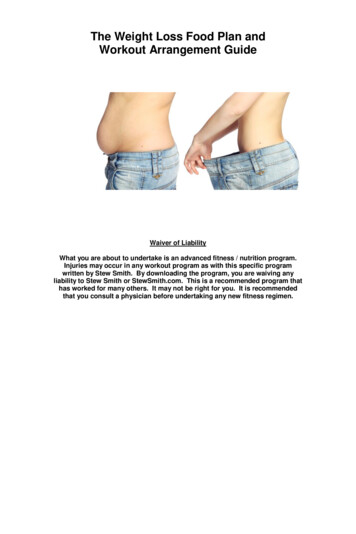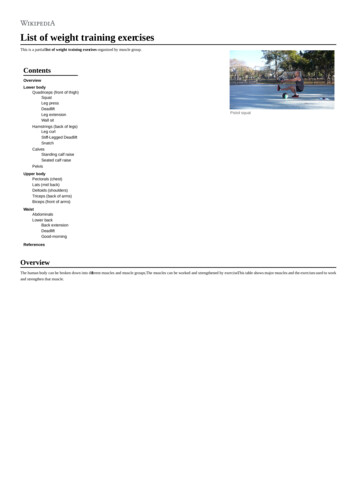
Transcription
List of weight training exercisesThis is a partial list of weight training exercises organized by muscle group.ContentsOverviewLower bodyQuadriceps (front of thigh)SquatLeg pressDeadliftLeg extensionWall sitPistol squatHamstrings (back of legs)Leg curlStiff-Legged DeadliftSnatchCalvesStanding calf raiseSeated calf raisePelvisUpper bodyPectorals (chest)Lats (mid back)Deltoids (shoulders)Triceps (back of arms)Biceps (front of arms)WaistAbdominalsLower backBack extensionDeadliftGood-morningReferencesOverviewThe human body can be broken down into different muscles and muscle groups.The muscles can be worked and strengthened by exercise.This table shows major muscles and the exercises used to workand strengthen that muscle.
LowerbackSquatSomeYesSomeYesYesSomeLeg sLeg curlSomeStandingcalf raiseYesSeatedcalf raiseYesHipadductorYesYesYesBenchpressYesSomeChest extensionYesSomeSomeBicepscurlCrunchYesYes
RussiantwistYesLeg raiseBackextensionYesSomeYesSomeYesLower body[1]Quadriceps (front of thigh)SquatThe squat is performed by squatting down with a weight held across the upper back under neck and standing up straight again. This is a compoundexercise that also involves the glutes (buttocks) and, to a lesser extent, the hamstrings, calves, and the lower back. Lifting belts are sometimes used tohelp support the lower back.The freeweight squat is one of 'The Big Three'powerlifting exercises, along with thedeadlift and the bench press.[2]EquipmentSquats can be performed using only the practitioner's body weight. For weighted squats, a barbell istypically used, although the practitioner may instead hold dumbbells, kettlebells, or other weighted objects.Individuals uncomfortable performing freeweight squats may use a Smith machine or hack squat machine.Major variantsCommon variations include front squats, in which the weight is held across the upper chest, and boxsquats, in which the practitioner rests briefly on a box or bench at the bottom of the movement.Hack squat machineLeg pressThe leg press is performed while seated by pushing a weight away from the body with the feet. It is a compound exercise that also involves the glutes and, to a lesser extent, the hamstrings and thecalves. Overloading the machine can result in serious injury if the sled moves uncontrollably towards the trainer.[3]EquipmentLeg press machine.DeadliftThe deadlift is performed by squatting down and lifting a weight off the floor with the hand until standing up straight again. Grips can be face down oropposing with one hand down and one hand up, to prevent dropping. Face up should not be used because this puts excess stress on the inner arms. This isa compound exercise that also involves the glutes, lower back, lats, trapezius (neck) and, to a lesser extent, the hamstringcacas and the calves. Liftingbelts are often used to help support the lower back. The deadlift has two common variants, the Romanian deadlift and the straight-leg-deadlift. Eachtarget the lower back, glutes and the hamstrings differently.EquipmentDumbbells, barbell, trapbar or Smith machine.Major variantsSumo (wider stance to emphasise the inner thighs); stiff legged (emphasizes hamstrings); straight-leggeddeadlift (emphasizes lower back).Dumbbell deadliftLeg extensionThe leg extension is performed while seated by raising a weight out in front of the body with the feet. It is an isolation exercise for the quadriceps.Overtraining can cause patellar tendinitis.[4] The legs extension serves to also strengthen the muscles around the knees and is an exercise that is preferredby physical therapists.EquipmentDumbbell, cable machine or leg extension machine.Wall sitThe wall sit, also known as a static squat, is performed by placing one's back against a wall with feet shoulder width apart, and lowering the hips until theLeg extension machineknees and hips are both at right angles. The position is held as long as possible. The exercise is used to strengthen the quadriceps. Contrary to previousadvice in this section, this exercise is NOT good for people with knee problems because the knees bear most of the load, especially when they are held atright angles (90 degrees).EquipmentBody weight, wall or other flat vertical surface, exercise ball placed behind the back is optional as well.Hamstrings (back of legs)Leg curlThe leg curl is performed while lying face down on a bench, by raising a weight with the feet towards the buttocks. This is an isolation exercise for thehamstrings.[5]EquipmentDumbbell, cable machine or leg curl machine.
Major variantsSeated (using a leg curl machine variant); standing (one leg at a time).Stiff-Legged DeadliftThe Stiff-Legged Deadlift is a deadlift variation that specifically targets the posterior chain. Little to no knee movement occurs in this exercise to ensurehamstring, glute, and spinal erector activation. The bar starts on the floor and the individual sets up like a normal deadlift but the knees are at a 160 angle instead on 135 on the conventional deadlift.Leg curl machineSnatchThe snatch is one of the two current olympic weightlifting events (the other being the clean and jerk). The essence of the event is to lift a barbell from the platform to locked arms overhead in a smoothcontinuous movement. The barbell is pulled as high as the lifter can manage (typically to mid [ chest] height) (the pull) at which point the barbell is flipped overhead. With relatively light weights (as inthe "power snatch") locking of the arms may not require rebending the knees. However, as performed in contests, the weight is always heavy enough to demand that the lifter receive the bar in asquatting position, while at the same time flipping the weight so it moves in an arc directly overhead to locked arms. When the lifter is secure in this position, he rises (overhead squat), completing thelift.CalvesStanding calf raiseThe standing calf raise is performed by plantarflexing the feet to lift the body. If a weight is used, then it rests upon the shoulders, or is held in thehand(s). This is an isolation exercise for thecalves; it particularly emphasises thegastrocnemius muscle, and recruits the soleus muscle.[6]EquipmentBody weight, dumbbells, smartbells, doorbells, cowbells, bell peppers, barbell, Smith machine or standingcalf raise machine.Major variantsOne leg (the other is held off the ground); donkey calf raise (bent over with a weight or machine pad on thelower back).Seated calf raiseThe seated calf raise is performed by flexing the feet to lift a weight held on the knees. This is an isolation exercise for the calves, and particularlyemphasises the soleus muscle.[7]Dumbbell standing calf raiseEquipmentBarbell or seated calf raise machine; can also be done on a leg press machine.PelvisVaginal weightlifting refers to strength training using the contraction of the pelvic floor muscles to lift weights after inserting anattachment in the vagina.Upper bodySeated calf raise machinePectorals (chest)The bench press or dumbbell bench-pressis performed while lying face up on a bench, by pushing a weight awayfrom the chest. This is a compound exercise that also involves the triceps and the front deltoids, also recruits the upperand lower back muscles, and traps. The bench press is the king of all upper body exercises and is one of the mostpopular chest exercises in the world. It is the final exercise in 'The big 3'.Equipment: dumbbells, barbell, Smith machine or bench press machine.Major variants: incline (more emphasis on the upper pectorals), decline (more emphasis on the lower pectorals),narrow grip (more emphasis on the triceps),push-up (face down using the body weight), neck press (with the barover the neck, to isolate the pectorals), vertical dips (using parallel dip bars) or horizontal dips (using two bencheswith arms on the near bench and feet on the far bench, and dropping the buttocks to the floor and pushing back up.)Smith machine bench pressThe chest fly is performed while lying face up on a bench or standing up, with arms outspread holding weights, by bringing the arms together above the chest. This is a compoundexercise for the pectorals. Other muscles worked includedeltoids, triceps, and forearms.Equipment: dumbbells, cable machine or "pec deck" machine.Major variants: incline (more emphasis on the upper pectorals), decline (more emphasis on the lower pectorals), cable crossover.Cable crossoversDipsLats (mid back)The pulldown is performed while seated by pulling a wide bar down towards the upper chest or behind the neck. This is a compound exercise that also involves the biceps,forearms, and the rear deltoids.Equipment: cable machine or pulldown machine.
Major variants: chin-up or pullup (using the body weight while hanging from a high bar), close grip (more emphasis on thelower lats), reverse grip (more emphasis on the biceps).Dumbbell flyePulldown machineThe Pull-up is performed by hanging from a chin-up bar above head height with the palms facing forward (supinated) and pulling the body up so the chin reaches or passes thebar. The pull-up is a compound exercise thatalso involves the biceps, forearms, traps, and the rear deltoids. A chin-up (palms facing backwards) places more emphasis on thebiceps and a wide grip pullup places more emphasis on the lats. As beginners of this exercise are often unable to lift their own bodyweight, a chin-up machine can be used withcounterweights to assist them in the lift.Equipment: chin-up bar or chin-up machine.The bent-over row is performed while leaning over, holding a weight hanging down in one hand or both hands, by pulling it uptowards the abdomen. This is a compound exercise that also involves the biceps, forearms, traps, and the rear deltoids. Thetorso is unsupported in some variants of this exercise, in which case lifting belts are often used to help support the lower back.Equipment: dumbbell, barbell, Smith machine or T-bar machine.Major variants: cable row (using a cable machine while seated).Dumbbell bent-over rowDeltoids (shoulders)The upright row is performed while standing, holding a weight hanging down in the hands, by lifting it straight up to thecollarbone. This is a compound exercise that also involves the trapezius, upper back, forearms, triceps, and the biceps.The narrower the grip the more the trapezius muscles are exercised.Equipment: dumbbells, barbell, Smith machine or cable machine.Cable machine upright rowThe shoulder press is performed while seated, or standing by lowering a weight held above the head to just above theshoulders, and then raising it again. It can be performed with both arms, or one arm at a time. This is a compound exercise thatalso involves the trapezius and the triceps.Major variants: 360 Degree Shoulder Press (wrists are rotated while weights are lifted, then weights are lowered in front of thehead before being rotated back to the first position).The military press is similar to the shoulder press but is performed while standing with the feet together. (It is named "military"because of the similarity in appearance to the "at attention" position used in most militaries) Unlike the seated shoulder press, themilitary press involves the majority of the muscles of the core as stabilizers to keep the body rigid and upright, and is thus a moreeffective compound exercise.Equipment: dumbbells, kettlebells, barbell, Smith machine or shoulder press machine.Major variants: Arnold Press (dumbbells are raised while rotating the palms outwards).Shoulder press machineThe lateral raise (or shoulder fly) is performed while standing or seated, with hands hanging down holding weights, by lifting them out to the sides until just below the level of theshoulders. A slight variation in the lifts can hit the deltoids even harder, while moving upwards, just turn the hands slightly downwards, keeping the last finger higher than thethumb. This is an isolation exercise for the deltoids. Also works the forearms and traps.
Equipment: dumbbells, cable machine or lateral raise machine.Major variants: front raise (lift weights out to the front; emphasis is on the front deltoids), bent-over (emphasis is on the rear deltoids),180 degree lateral raise (weights are held slightly in front of the body and lifted over the head in a circular motion).Dumbbell lateral raiseTriceps (back of arms)The pushdown is performed while standing by pushing down on a bar held at the level of the upper chest. It is important to keep theelbows at shoulder width and in line with shoulder/legs. In other words, elbows position should not change while moving the forearm pushesdown the bar. This is an isolation exercise forthe triceps.Equipment: cable machine or pulldown machine.Cable machine pushdownThe triceps extension is performed while standing or seated, by lowering a weight held above the head (keeping the upper armsmotionless), and then raising it again. It can be performed with both arms, or one arm at a time. This is an isolation exercise forthe triceps. It is also known as thefrench curl.Equipment: dumbbell(s), barbell, cable machine or triceps extension machine.Major variants: lying (lying face up with the weights over the face), kickback (bent over with the upper arm parallel to thetorso).Lying dumbbell triceps extensionBiceps (front of arms)The Preacher curl is performed while standing or seated, with hands hanging down holding weights (palms facing forwards), by curlingthem up to the shoulders. It can be performed with both arms, or one arm at a time.Standing barbell curlAlternating rotating dumbbell curlHammer curlThe Zottmann curl gives a stronger focus to forearm training compared to the traditional curl.Dumbbell biceps curl on thepreacher benchWaistAbdominalsThe crunch is performed while lying face up on the floor with knees bent, by curling the shoulders up towards the pelvis.This is an isolation exercise for the abdominals.Equipment: body weight, dumbbell or crunch machine.Major variants: reverse (curling the pelvis towards the shoulders), twisting or side (lifting one shoulder at a time;emphasis is on the obliques), cable (pulling down on a cable machine while kneeling), sit-up (have [chest] touchyour knees), vertical crunch (propping up to dangle legs and pulling knees to the [ chest] or keeping legs straight andpulling up legs to a 90 degree position). Reverse hanging crunch (using gravity boots or slings to hang head downand pulling to a 90 or 180 degree form)CrunchThe leg raise is performed while sitting on a bench or flat on the floor by raising the knees towards the shoulders, or legs to a vertical upright position. This is a compound exercisethat also involves the hip flexors.Equipment: body weight or dumbbell.Major variants: hanging (hanging from a high bar), side (lying on side), knee raise (lying on back, drawing knees to chest).
Seated leg raiseThe Russian twist is a type of exercise that is used to work the abdomen muscles by performing a twisting motion on the abdomen. This exercise is performed sitting on the floorwith knees bent like in a "sit-up" position with the back typically kept off the floor at an angle of 45 . In this position, the extended arms are swung from one side to another in atwisting motion with or without weight.Equipment: body weight,kettlebell, medicine ball, or dumbbell.Major variants: back kept off the floor at 45 angle, back rested on exercise ball, feet resting on the floor, anchored or kept off the floor.Lower backBack extensionThe back extension is performed while lying face down partway along a flat or angled bench, so that the hips are supported and the heels secured, bybending down at the waist and then straightening up again. This is a compound exercise that also involves the glutes.EquipmentBody weight, dumbbell or back extension machine.Major variantsWithout bench (lying face down on the floor).DeadliftBack extension on a Roman chairThe deadlift is a very effective compound exercise for strengthening the lower back, but also exercises many other major muscle groups, including quads,hamstrings and abdominals. It is a challenging exercise, as poor form or execution can cause serious injury.[8] A deadlift is performed by grasping a deadweight on the floor and, while keeping the back very straight, standing up by contracting the erector spinae (primary lower back muscle). When performed correctly, the role of the arms in the deadlift isonly that of cables attaching the weight to the body; the musculature of the arms should not be used to lift the weight. There is no movement more basic to everyday life than picking a dead weight up offof the floor, and for this reason focusing on improving one's deadlift will help prevent back injuries.Good-morningThe good-morning is a weight training exercise in which a barbell, two dumbbells, or no weight at all is held on the shoulders, behind the head. The person bends forward and bows at the hips andrecovers to upright. The good-morning is so called because the movement resembles bowing to greet someone. It involves the hamstrings but is primarily used to strengthen the lower back; the degree ofknee bend used will change the focus – nearly straight-legged involving the hamstrings most.References1. Johnson-Cane, Deidre; Cane, Jonathan; Glickman, Joe (2000).The Complete Idiot'sGuide to Weight Training. Indianapolis: Alpha Books. p. 169.ISBN 0-7865-4251-9.5. Johnson-Cane et al., p. 177.2. Johnson-Cane et al., p. 1707. Johnson-Cane et al., p. 180.3. Johnson-Cane et al., p. 173.8. Johnson-Cane et al., p. 1876. Johnson-Cane et al., p. 179.4. Johnson-Cane et al., p. 175.Retrieved from "https://en.wikipedia.org/w/index.php?title List of weight training exercises&oldid 837842394"This page was last edited on 23 April 2018, at 10:54(UTC).Text is available under theCreative Commons Attribution-ShareAlike License; additional terms may apply. By using this site, you agree to theTerms of Use and Privacy Policy.Wikipedia is a registered trademark of theWikimedia Foundation, Inc., a non-profit organization.
List of weight training exercises This is a partial list of weight training exercises organized by muscle group. Overview Lower body Quadriceps (front of thigh) Squat Leg press Deadlift Leg extension Wall sit Hamstrings (back of legs) Leg curl Stiff-Legged Deadlift Snatch Calves Standing cal
